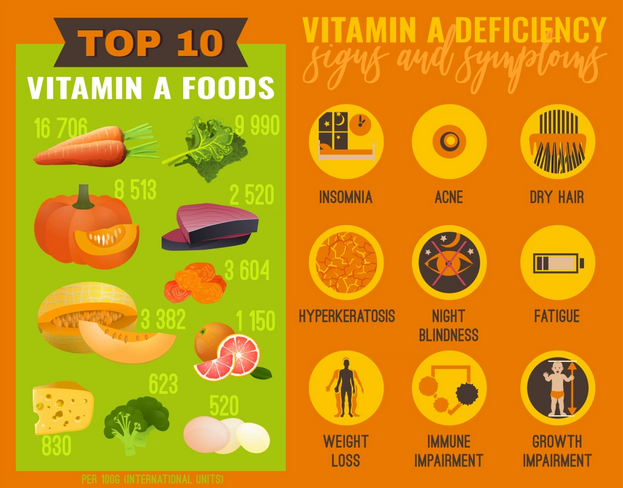Vitamin A – First in your heart, first on your chart
Vitamin A is actually a group of compounds used by the human body for growth and development, good vision, and the proper functioning of the immune system. It is necessary for gene transcription, blood cell development, and to maintain skin health.
The common types found in foods are provitamin A carotenoids (e.g. beta carotene), derived from plant sources (sweet potatoes, carrots, spinach, apricots) that are then converted into retinol within the body; and preformed A retinoids (Retinyl palmitate), which are active sources found in animal products (eggs, whole milk, meat – especially liver).
Beta-carotene has a much lower absorption amount than retinol, 9% vs. 90%. This makes it much more efficient to obtain the vitamin A from retinol rather than through the conversion process. This does not mean that you should forego a reasonable amount of beta-carotene rich vegetables.
Vitamin A is fat-soluable, so deficiencies can occur when following low-fat diets. Deficiences can also result from low zinc intake, as zinc is an essential factor in transport and conversion of vitamin A.
Due to the necessity of vitamin A in correct visual development, an early symptom of deficiency is impaired vision, especially night blindness. This is a major concern in developing countries, especially in Southeast Asia and Africa.

Most people are going to obtain adequate vitamin A from their normal food intake. The upper recommended limit for adults over 19 years old is 3,000 mcg/10,000 IU per day. Possible side effects of excessive amounts include headaches, vomiting, joint pain, mental confusion, vision problems, hair loss, and dry skin. It is important for pregnant women to have adequate intake of vitamin A, but not an excess, as high doses can lead to birth defects. Lowered bone density and liver problems can also develop from high doses. Alcohol and vitamin A are contraindicative.
The fat soluability of the provitamins means that the absorption of these compounds from plant food sources increases when they are ingested with lipids, i.e. fats/cholesterol. The other fat-soluable vitamins are D, E, and K.
The following list indicates common food sources of vitamin A¹:
- cod liver oil (30000 μg 3333%)
- liver (turkey) (8058 μg 895%)
- liver (beef, pork, fish) (6500 μg 722%)
- liver (chicken) (3296 μg 366%)
- ghee (3069 μg 344%)
- sweet potato (961 μg 107%)
- carrot (835 μg 93%)
- broccoli leaf (800 μg 89%)
- butter (684 μg 76%)
- kale (681 μg 76%)
- collard greens (frozen then boiled) (575 μg 64%)
- butternut squash (532 μg 67%)
- dandelion greens (508 μg 56%)
- spinach (469 μg 52%)
- pumpkin (426 μg 43%)
- collard greens (333 μg 37%)
- cheddar cheese (265 μg 29%)
- cantaloupe melon (169 μg 19%)
- bell pepper/capsicum, red (157 μg 17%)
- egg (140 μg 16%)
- apricot (96 μg 11%)
- papaya (55 μg 6%)
- tomatoes (42 μg 5%)
- mango (38 μg 4%)
- pea (38 μg 4%)
- broccoli florets (31 μg 3%)
- milk (28 μg 3%)
- bell pepper/capsicum, green (18 μg 2%)
- spirulina (3 μg 0.3%)
The common question with all supplementation is “if I take more of this, will it improve my X, Y, and Z?” The answer is – maybe. One thing to note is since vitamin A is stored in fat tissue, it is possible to accumulate excessive amounts if you are mega-dosing. Most people who eat a balanced diet will get sufficient amounts directly from food sources. If you supplement with vitamin A, keep an eye out for possible side effects like nausea/vomiting , fatigue, irritability/changes in mental state, anorexia, fevers, or stomach problems. One option is to supplement with beta-carotene, rather than take vitamin A directly, and let your body do the manufacturing. As with all supplements, consult a medical professional before adding a new supplement to your regimen.
¹Source: https://en.wikipedia.org/wiki/Vitamin_A
Share this article on your social media
Print
Published on September 3, 2018.


